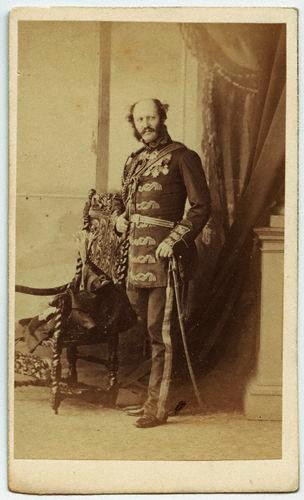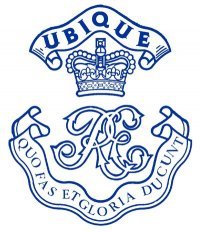
The Corps of Royal Engineers, usually called the Royal Engineers (RE), and commonly known as the Sappers, is the engineering arm of the British Army. It provides military engineering and other technical support to the British Armed Forces and is headed by the Chief Royal Engineer. The Corps Headquarters and the Royal School of Military Engineering are in Chatham in Kent, England. The corps is divided into several regiments, barracked at various places in the United Kingdom and around the world.

During the American Civil War, the United States Army, the land force that fought to preserve the collective Union of the states, was often referred to as the Union Army, the Grand Army of the Republic, the Federal Army, or the Northern Army. It proved essential to the restoration and preservation of the United States as a working, viable republic.

The Royal Logistic Corps provides logistic support functions to the British Army. It is the largest Corps in the Army.

A military staff or general staff is a group of officers, enlisted and civilian staff who serve the commander of a division or other large military unit in their command and control role through planning, analysis, and information gathering, as well as by relaying, coordinating, and supervising the execution of their plans and orders, especially in case of multiple simultaneous and rapidly changing complex operations. They are organised into functional groups such as administration, logistics, operations, intelligence, training, etc. They provide multi-directional flow of information between a commanding officer, subordinate military units and other stakeholders. A centralised general staff results in tighter top-down control but requires larger staff at headquarters (HQ) and reduces accuracy of orientation of field operations, whereas a decentralised general staff results in enhanced situational focus, personal initiative, speed of localised action, OODA loop, and improved accuracy of orientation.

The Royal New Zealand Army Logistic Regiment, is the New Zealand Army's main military Logistics and combat service support (CSS) element. It is the largest regiment in the NZ Army.

Sir William Montagu Scott McMurdo was a British army officer who rose to the rank of general. He saw active service in India, helped to run a military railway in the Crimean War and then managed various groups of volunteers working with the army. He was eventually knighted.

The Corp of Sri Lanka Engineers (SLE) is a combat support arm of the Sri Lanka Army which provides military engineering. It is made up of ten regular regiments and one volunteer regiment. Headquartered at Panagoda Cantonment, it is headed by the Centre Commandant.
160 Transport Regiment Royal Logistic Corps (Volunteers), was a regiment of the Territorial Army in the United Kingdom.

The Royal Australian Corps of Transport (RACT) is an administrative corps within the Australian Army. The RACT is ranked tenth in seniority of the corps of the Australian Army, and is the most senior logistics corps. It was formed on 1 June 1973 as an amalgamation of the Royal Australian Army Service Corps (RAASC) and Royal Australian Engineers Transportation Service. The RACT is responsible for the operation of army surface transport assets, movement control, terminal and postal services, and Army aspects of air logistic support.
The New Year Honours 1968 were appointments in many of the Commonwealth realms of Queen Elizabeth II to various orders and honours to reward and highlight good works by citizens of those countries. They were announced in supplements to the London Gazette of 29 December 1967 to celebrate the year passed and mark the beginning of 1968.

Charles Manby, FRS FRSA was Secretary of the Institution of Civil Engineers from November 1839 to 1856, and engineer of the first iron steamer to cross the English Channel. Fluent in French, he installed gas piping into Paris and advised on the construction of the Suez Canal.
The 1948 New Year Honours were appointments by many of the Commonwealth realms of King George VI to various orders and honours to reward and highlight good works by citizens of those countries. They were announced on 1 January 1948 for the British Empire and New Zealand to celebrate the past year and mark the beginning of 1948. By coincidence it coincided with the nationalization of the Big Four railways into what is now known as British Railways.
The 1947 King's Birthday Honours were appointments by many of the Dominions of King George VI to various orders and honours to reward and highlight good works by citizens of those countries. The appointments were made "on the occasion of the Celebration of His Majesty's Birthday." They were announced in supplements to the London Gazette of 6 June 1947.
The 1947 New Year Honours were appointments by many of the Commonwealth Realms of King George VI to various orders and honours to reward and highlight good works by citizens of those countries. They were published on 31 December 1946.
The King's Birthday Honours 1942 were appointments by King George VI to various orders and honours to reward and highlight good works by members of the British Empire. They were published on 5 June 1942 for the United Kingdom and Canada.
The 1944 New Year Honours were appointments by many of the Commonwealth realms of King George VI to various orders and honours to reward and highlight good works by citizens of those countries. They were announced on 31 December 1943.
The King's Birthday Honours 1943 were appointments by King George VI to various orders and honours to reward and highlight good works by people of the British Empire. They were published on 2 June 1943 for the United Kingdom and Canada.
The 1928 Birthday Honours were appointments by King George V to various orders and honours to reward and highlight good works by citizens of the British Empire. The appointments were made to celebrate the official birthday of The King, and were published in The London Gazette on 4 June 1928.
The 1881 Birthday Honours were appointments by Queen Victoria to various orders and honours to reward and highlight good works by citizens of the British Empire. The appointments were made to celebrate the official birthday of the Queen, and were published in The London Gazette on 24 May 1881.
Major-General George "Gus" Brian Sinclair was a British Army officer. After the Royal Military Academy Sandhurst Sinclair joined the Royal Engineers in 1948. He served in Korea during the aftermath of the Korean War and was quickly appointed adjutant of his regiment. Sinclair served as adjutant of the British garrison on Kiritimati for the Operation Grapple thermonuclear weapon tests. From 1969 he was Commander Royal Engineers Near East Land Forces, based at the Sovereign Base Areas of Akrotiri and Dhekelia and was responsible for recovering buildings from a British training base abandoned in the aftermath of the 1969 Libyan coup d'état.










